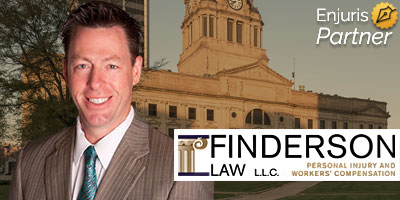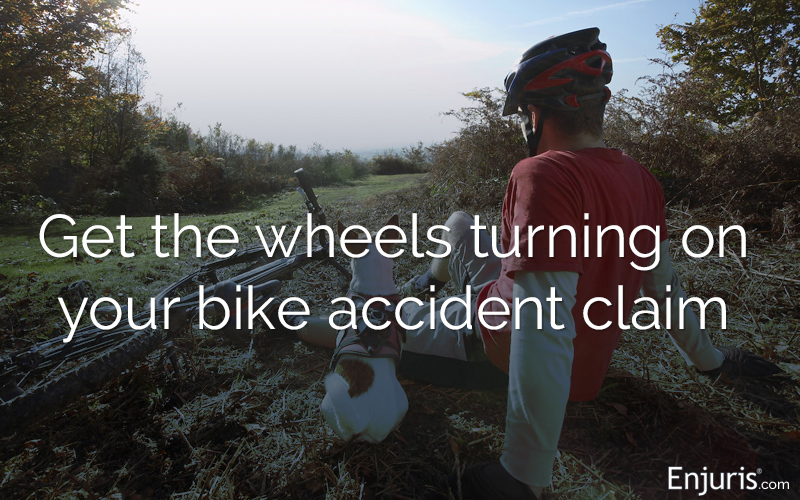Who’s liable when a bicyclist and driver collide?
Indiana is considered the 24th most bicycle-friendly state by the League of American Bicyclists (LAB). The state is recognized as having 58 bicycle-friendly companies and 12 bicycle-friendly communities.
When things go right, bicycles and motor vehicles share the road in perfect harmony. But since you’re reading this article, you probably already know that things don’t always go right.
Let’s take a look at bicycle accidents in Indiana, including the laws that impact bicyclists and how injured bicyclists can establish liability after a bicycle accident.
Indiana bicycle laws
Indiana bicycle laws can be found in Title 9, Article 21, Chapter 11 of the Indiana Code. The first thing to recognize is that bicyclists in Indiana have all the rights and duties that motor vehicle drivers have when using the roadway.
Additionally, there are specific laws that apply to bicyclists:
Bicycle-equipment laws
- A person operating a bicycle may not ride on anything other than the permanent and regular seat attached to the bicycle. Similarly, a person operating a bicycle may not allow a passenger to ride on anything other than a firmly attached and regular seat on the bicycle
- A person on a bicycle may not use a siren or whistle while on a bicycle.
- A bicycle being operated on a highway from sunset to sunrise must be equipped with: a lamp on the front exhibiting a white light visible from a distance of at least 500 feet, and a lamp on the rear exhibiting a red light visible from a distance of 500 feet or a red reflector visible from a distance of 500 feet.
- A bicycle must be equipped with a brake that will enable the person who operates the bicycle to make the braked wheels skid on dry, level, clean pavement.
- Bicycle operators and passengers are NOT required to wear bike helmets.
Bicycle-operation laws
- A person riding a bicycle must obey all the rules of the road (traffic control devices, etc.).
- A person riding a bicycle may not ride more than 2 abreast except on paths or parts of the road set aside for the exclusive use of bicycles.
- A person riding a bicycle may not carry a package or object that prevents the person from keeping both hands on the handlebars.
A person who violates any of the above laws commits a Class C infraction, which generally carries with it a $500 penalty.
Determining fault in an Indiana bicycle accident lawsuit
The vast majority of personal injury claims made by bicyclists against motor vehicle drivers after a bicycle accident are negligence claims. To prove negligence in Indiana, a bicyclist must show that:
- The driver owed the bicyclist a duty. All drivers have a duty to exercise reasonable care to avoid harming others on the road.
- The driver breached their duty. To prove that a driver breached their duty, the bicyclist will have to show that the driver failed to exercise a reasonable degree of care. One way to do this is to show that a driver violated a statute (such as speeding, driving under the influence of alcohol, or driving while texting).
- The bicyclist was injured as a result of the driver’s breach. It’s not enough that the driver failed to exercise reasonable care, the bicyclist must prove that this specific failure was the cause of the accident.
A minor, William Rayborn, was riding a bicycle south on South Dunn Street in Bloomington, Indiana, approaching the intersection of East Allen Street and South Dunn Street. A bus was traveling east on East Allen Street approaching the intersection at the same time.
The bus and the bicycle collided at the intersection, resulting in fatal injuries to William.
A subsequent investigation revealed that the bus driver was talking to another passenger sitting to the driver’s right. The investigation also revealed that the bus had a yield-the-right-of-way sign and that several passengers saw the bicyclist well in advance of the intersection but the bus driver didn’t apply the brakes until after the bus collided with the bicyclist.
Finally, the investigation revealed that the bus proceeded for 75-100 feet after colliding with the bicyclists and that the bicyclist was dragged underneath the lower front part of the bus.
The jury found that the bus driver was negligent and awarded William’s family damages.
Of course, not all accidents are caused by motor vehicle drivers. Other responsible parties may include:
- Bicyclists. Just as drivers owe others on the road a duty to exercise reasonable care, bicyclists owe others on the road the same duty. If a bicyclist breaches this duty and another bicyclist (or driver) is injured as a result, the bicyclist is negligent.
- Pedestrians. Just like drivers and bicyclists, pedestrians owe others on the road a duty to exercise reasonable care.
- Towns or cities. In general, premises liability laws require property owners to maintain their property free from dangerous conditions. If a bicyclist is injured as a result of a dangerous condition (such as a large pothole or faded road marking), the owner of the property (often the town or city in the case of a public road) can be held liable.
- Manufacturers. If a bicycle accident is caused by a defective product (such as a cracked bike fork), the manufacturer may be liable.
Comparative fault laws in Indiana
Sometimes both the bicyclist and the motor vehicle driver are at fault for an accident.
Indiana is a modified comparative fault state, which means that the plaintiff’s damages are reduced by their percentage of fault. What’s more, if the plaintiff is considered more than 50% at fault for the accident, the plaintiff is barred from recovering any damages.
Consider the following example:
Joe is driving east on Douglas Road toward the same intersection, but Joe doesn’t have a stop sign.
Michael blows right through the stop sign and collides with Joe. Michael suffers catastrophic injuries and sues Joe for $2 million.
The jury finds that Joe was speeding and was therefore 30% at fault for the accident. The jury also finds that Michael was 70% at fault for running a stop sign. Under Indiana’s modified comparative fault statute, Michael is barred from recovering any damages (because he was found more than 50% at fault for the accident).
Types of bicycle injuries and damages
It’s not surprising that when a bicyclist and motor vehicle driver collide, the bicyclist is more likely to be injured.
A study conducted by researchers at the University of Washington School of Medicine found that most bicycle-related injuries occur to the upper or lower extremities, followed by the head, face, abdomen, and neck.
While most injuries involve superficial trauma, such as abrasions and lacerations, roughly 34% of injured bicyclists suffer head injuries, and head injuries are responsible for over 60% of all bicycle-related deaths and the majority of long-term disabilities.
Fortunately, Indiana allows injured cyclists to seek both economic and noneconomic damages:
- Economic damages. Economic damages represent the monetary losses caused by an accident and include things like medical expenses, lost income, and property damage.
- Noneconomic damages. Noneconomic damages represent the non-monetary losses caused by an accident and include things like pain and suffering and emotional distress.
In addition to compensatory damages, plaintiffs may be entitled to punitive damages if the defendant’s conduct was intentional or malicious.
What to do (and NOT do) after a bicycle accident in Indiana
Step 1: Seek medical attention
Following a bicycle accident, your health should be your top priority. Call an ambulance (or have someone call one for you) if appropriate. Even if you don’t feel your injury is serious enough to warrant an ambulance, you should still visit your doctor as soon as possible. The symptoms of many injuries, including some serious internal injuries, don’t surface until hours or even days after an accident.
Step 2: Call the police
Once you’ve taken care of your immediate health needs, be sure to call the police if they haven’t already arrived on the scene. The police can draft a report and conduct a simple investigation that may help support your future insurance claim or lawsuit. With this goal in mind, don’t hesitate to tell the responding officer your side of the story.
Step 3: Take pictures and gather witness info
Though the responding officer may conduct an investigation, it’s important that you don’t rely entirely on their efforts. If it’s safe to do so, gather the names and contact information of any witnesses, take photographs of your injuries and the accident scene, and write down your version of events while it’s still fresh in your head.
Step 4: Notify your insurance company
Your own auto insurance may cover bicycle accidents. Many auto insurance policies cover bike accidents so long as the bicyclist was hit by a motor vehicle. Review your policy to see if coverage exists and contact your auto insurance company if you have any questions.
Step 5: Meet with a personal injury attorney near you
Following the accident, the driver’s insurance company may call you and offer to settle the case for a sum of money in exchange for a release of liability. Be very careful before accepting any settlement offer and signing a release. Initial offers are often low. Regardless, it’s unlikely that you’ll know the full extent of your injuries immediately after an accident.
Instead, meet with a personal injury attorney to discuss your case. An experienced attorney, even during a free initial consultation, can generally tell you whether an initial offer is fair or not.
How to prevent bicycle accidents
Former Olympic cyclist Nicole Freedman offers 3 pieces of advice for cyclists based on the accidents she’s seen:
- Stay clear of large trucks. Nicole explains that the last place a bicyclist should be is on the right side of a large truck. A bicyclist on the truck driver’s right may be in their blind spot and it’s often impossible for a cyclist to see the truck’s turn signal flashing from this position.
- Be hyper-aware of your surroundings. Be aware of trucks, cars, and pedestrians, and try to predict what they’re going to do next.
- Give parked cars a wide berth. The term “dooring” refers to when cyclists are hit by drivers opening car doors and it’s one of the most common causes of bicycle accidents.
Other safety tips from the League of American Bicyclists include:
- Wear a properly fitted helmet and reflective clothing.
- Make sure your bike is fit for riding before every ride (check the tires, brakes, etc.).
- Learn the rules of the road and follow them.
- Communicate clearly with those around you (make eye contact and use hand signals when appropriate).
If the worst happens and you’re injured in a bicycle accident, you don’t have to handle the aftermath alone. Use our free online directory to reach out to a qualified Indiana personal injury attorney in your area. Most initial consultations are free and provide a no-commitment opportunity to review your options.
See our guide Choosing a personal injury attorney.


